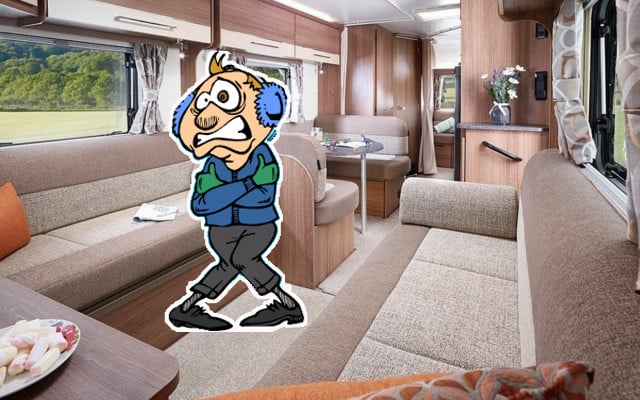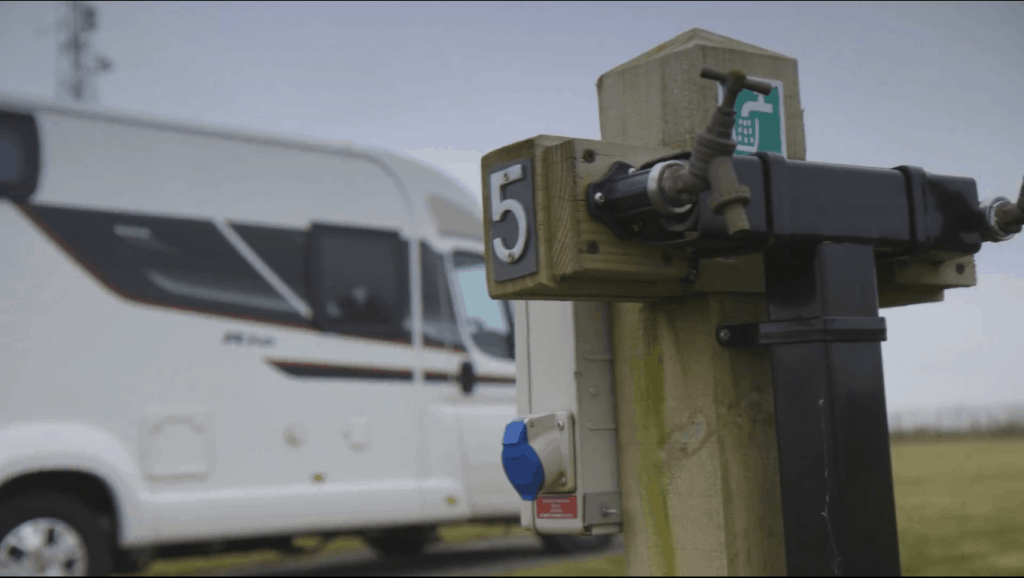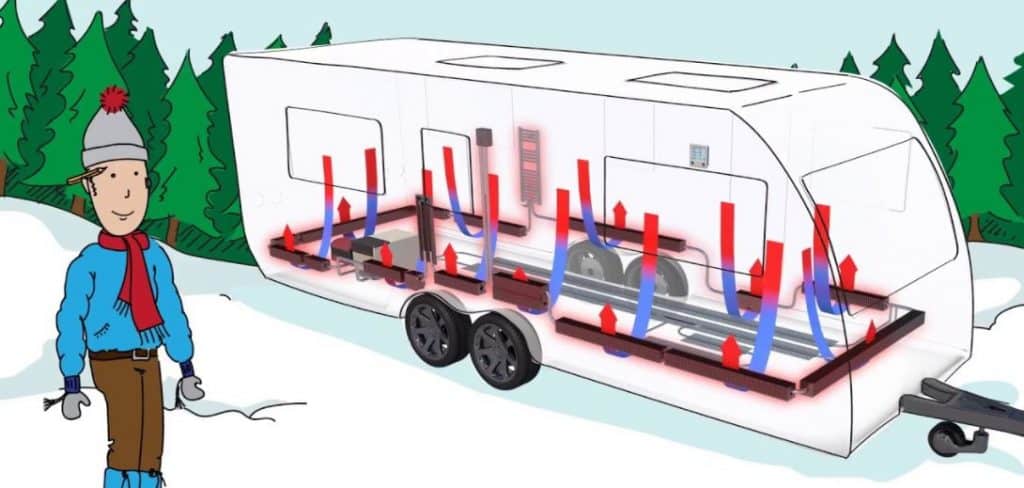
While I actually close Horton Common over the winter months, caravan heating systems are a topic I have discussed with our guests quite a few times over the years. Modern caravans and motorhomes come with various heating system options to stay warm. However, electrical heating elements can fail, gas burners may fail to ignite, and circuit board controllers can go kaput. Therefore later in this post, after discussing the main heating system options for caravans and motorhomes, I will also discuss backup heating solutions.

I’ve previously written posts such as the pros and cons of Alde central heating and Alde vs Truma heating systems.
So if you are looking for details on the specifics of the different systems, those posts contain more detail.
This post is a general overview of caravan heating system options with the help of an informative video from the very experienced caravanner Andrew Ditton.
You have probably found this post while researching the different caravan heating system options for a new caravan purchase.
However, there is another question that I think more people should be asking caravan manufacturers now and in the future.
How well insulated is the caravan or motorhome? Caravan and motorhome body construction has changed significantly over the last couple of decades.
Most manufacturers have moved on from a simple wood frame and plywood/aluminium skin. There are now manufacturing solutions such as Bailey’s Alu-Tech and Swifts SMART system, to name but a few.
My point is you need to consider the caravan’s body construction/insulation as an important factor in staying warm. Its not just the type of caravan heating system installed that you need to consider.
Disclaimer: Hey! By the way… any links on this page that lead to products on Amazon or Caravan Guard are affiliate links, and I earn a commission if you make a purchase, with no additional cost to you 🙂
- Dissolves waste and removes odours naturally and has delightful mild fragrance
Want To Visit Horton Common? – Book Here
Table of Contents
Introduction To Caravan Heating Systems
There are a couple of different heating systems applicable to caravans and motorhomes. There is the simple convection heater (gas or electric).
Then there is the choice of either a blown air heating system produced, most likely by Truma. Or a wet central heating system, most likely produced by Alde.
As I’ve discussed in my posts linked above, both of these caravan heating systems have pros and cons, strengths and limitations.
To add some additional context to the discussion on caravan heating systems, I recently came across a video about how to stay warm in a caravan by Andrew Ditton.
Andrew is a very experienced leisure industry journalist and has personal experience with a wide range of different caravans and their various heating systems.
Therefore, I wanted to include Andrews’s video in the post. I think his opinions on the topic of caravan heating systems carries significant weight.
I believe in the video above, Andrew discusses quite a few important points with regard to caravan heating systems.
For instance, with regards to which energy source you can/choose to use and how different heating technologies (blown air/wet central heating) suit different caravan layouts and furniture construction.
So below are some of my own thoughts on the video above and caravan heating systems.
Using Gas vs Electricity For The Caravan Heating System
Most caravan sites in the UK, including our own here at Horton Common, will offer an electric hook-up for caravans and motorhomes.
Many such as ours, will offer a maxium of 16A connection per pitch. At 230/240V, the pitch electrical supply can provide around 3680W (3.7KW) of power.
Caravan heating systems from Alde and Truma can both produce heating and hot water using the mains electric connection. However, you need to be aware of the limitations on heat output.
For instance, depending on the wattage of your caravan kettle or caravan microwave, you may only be able to run the heating system on the lower electrical power setting without tripping the supply.
You may even have air conditioning which in the summer months can compete for power with the hot water system. The above constraints apply for a full 16A (3.7kW) pitch hook-up.
Therefore the situation can be even more tricky on caravan sites that only provide a 10A, 6A or even a 3A connection per pitch.

The point is, as Andrew references in the video above, on very cold days, even with a mains hook-up, you may need to run the caravan heating system on gas.
Now, running on gas may only be required initially or when you are having a shower.
After the caravan living space is at a reasonable temperature, you may be able to keep the living space/hot water maintained on the mains electrical supply alone.
With that being the case, if you do use your caravan a lot, it may be worth considering a refillable gas bottle instead of the higher cost per litre of gas with the bottle exchange system.
How Efficient Are Caravan Heating Systems?
As Andrew discusses in the video above, with the Truma blown air systems depending on the caravan layout, you sometimes find hot air ventilation pipes under the caravan body.
This is not ideal, as energy will be lost through the wall of the pipe before the hot air reaches its intended location. Usually, a rear washroom or enclosed bedroom.
Now, as discussed in my post on Alde vs Truma and by Andrew in the video above, those exterior hot air ventilation pipes should be insulated.
However, you will find many caravans which do not have insulated exterior hot air ventilation pipes. Therefore, many owners end up carrying out the work themselves.
Why every caravan manufacturer who adopts this heating system design doesnt insulate the pipes is beyond me and very frustrating/disappointing.
The point is though if you are looking at a caravan with a blown air heating system, you need to look out for uninsulated exterior hot air ventilation pipes.
Caravan Wet Central Heating Designs (Radiators vs UFH)
However, its not only the Truma hot air heating systems which are sometimes not ideally designed in caravans.
Alde wet central heating systems are implemented in some caravans and motorhomes better than others.
As I discuss in my post on Alde wet central heating and by Andrew in the video above, it is not as quick to provide a noticeable heat difference as a hot-blown air system.
Therefore using the control/panel timers and smartphone app, you have to plan ahead more of when you will be in the caravan, when you will be sleeping etc.
With Alde wet central heating systems, they may be designed with small radiators positioned around the caravan or via underfloor heating pipes (UFH).
As Andrew discusses in the video above, with the radiator set up, the caravan manufacturer should have designed sufficient ventilation gaps around the bottom of the seating area or beds.
If such ventilation gaps are not provided, you will likely feel that the bottom half of the caravan/motorhome is colder, maybe even uncomfortably so.
Therefore, before you choose a caravan with Alde wet central heating, ask if it uses radiators or an underfloor heating loop.

Caravan Heating Back-Up Plans
Whether you have Truma hot-blown air heating in your caravan or motorhome or Alde wet central heating, its important to get them serviced.
Whether its checking that the gas burner is working efficiently or the wet central heating is topped up with Glycol, both types of caravan heating systems need attention.
However, sometimes even with proper servicing, things can go wrong and break. And ‘sod’s law’ dictates if something can go wrong with your caravan heating system, it will do so while you are on holiday.
Therefore if you are out in your caravan or motorhome during the colder months of the year, its important to have a heating backup plan.
Low Wattage Portable Electric Heaters
So the first, most obvious and potentially safest backup heating option to consider is a low-wattage portable electric heater.
Notice my specific reference to ‘low-wattage’, you don’t just want to choose just any portable domestic electric heater.
Many electric heaters for a domestic environment are rated at 3kW. Hence even on a 16A (3.7kW) pitch, you are going to be close to tripping the supply if you turn on any additional appliances/devices.
A popular portable and, importantly low wattage electric heater is the Kampa Diddy, as seen in the image below.

The Kampa Diddy is a popular portable electric heater with 750W and 1500W power settings: Image – Amazon.co.uk
I have been asked in the past by a guest if it would be possible to run such a low-wattage heater from their 12V leisure battery, as they also had a solar panel.
While technically possible with a 12V to 230V inverter, even with a solar panel, you are not going to be able to run that heater for long.
You also have to remember you would want to run this heater in the cold months of the year. Well, during the colder months of the year, your caravan solar panel is also producing less energy.
Therefore, without multiple leisure batteries and multiple solar panels running, an electric heater without the mains is just not viable.
Use Alcohol Heaters/Stoves With Caution
As Andrew references alcohol heaters/stoves in his video above as a back-up heating option, I do need to address them. However, I do so slightly reluctantly.
As Andrew does state in the video above (with a large flashing label), with any internal combustion appliance, you need to be aware of the risk of carbon monoxide.
I’ve recently written a post on caravan fire safety equipment where I discuss my thoughts on the best carbon monoxide alarm options.
Using an internal burning appliance for long periods of time does come with a higher risk of carbon monoxide poisoning. Hence, this is why you will often be told never to use a gas stove as a heat source.

Before you chose an alcohol stove or any combustion device as a backup heating solution you need to carefully consider the carbon monoxide risk: Image – Amazon.co.uk
Therefore, if you were to use an alcohol stove such as the Dometic Origo as backup heat source, you must only do so with a window open and a working carbon monoxide alarm.
And you must never use a gas stove/alcohol stove as a backup source of heating while you are sleeping. Carbon monoxide has no smell or taste. Furthermore, it actually makes you feel tired and sleepy.
Therefore, I’m personally very reluctant to actually recommend an alcohol stove or any internal combustion device as a backup heating solution for a caravan or motorhome.
Conclusions On Caravan Heating Systems
When I read some caravan/motorhome comment treads, or I talk to some of our guests about caravan heating systems, there can be a tendency for some people to get a bit ‘tribal’.
In other words, some people will proclaim that Alde wet central heating is always superior to blown air heating due to the noise.
Or that Truma blown air heating is superior to Alde wet central heating as it has a quicker heating response time. I don’t personally subscribe to either of these camps.
Really, I just think that each type of heating system has its strengths and weaknesses. I believe which system is best varies very much on the particular caravan layout and how the heating system is designed and installed.
Therefore, when you are considering a new caravan/motorhome or potentially even a second-hand caravan or used motorhome, keep all heating system options on the table.
Bear in mind the potential drawbacks of each caravan heating system referenced above and in my other linked posts.
You will then be in a much better position to objectively judge whether, for that particular caravan/motorhome and its layout if the chosen heating system is going to perform to the best of its ability.
Thanks for reading, I hope you found the video above from Andrew and my own comments interesting and informative.
I also hope in the near future, you will consider coming to visit us here at Horton Common caravan site. 🙂
Want To Visit Horton Common? – Book Here


